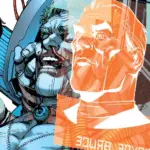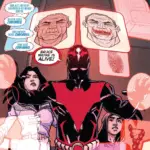Superhero comics can be intimidating to get into. The genre’s been dominating movies ever since Robert Downey Jr. put on his first set of motion-capture pyjamas, and there’s an ever-growing pile of superhero shows on TV and Netflix to choose from. These superhero stories are more accessible than ever, but the actual comics that most of the colourful caped champions were created in often have decades of lore, characters and crossovers to try to untangle. For an aspiring new reader, it can be extremely overwhelming. What’s a superhero fan to do, aside from give up and go wait for season three of Young Justice? Or as well as that?
Well, as a new comic fan, I personally was quite relieved to hear of DC’s Rebirth initiative—all those issue zeroes providing a clear and easy point to step-in and start reading. Even better, among the three hundred and five Batman-related books was Batman Beyond Rebirth (BBR), a comics version of my absolute favourite installment of the DCEU. Less than ten issues in, the series has had some ups and downs, but the latest revelation shows how determined Dan Jurgens is to set this book apart from the rest of the all-consuming Batman stories.
**Full spoilers for Batman Beyond Rebirth #0-8**
Issue #0: Rebirth, or, Terry’s City Now
As well as a pitch to gauge reader interest, this premiere issue is an introduction to the world of Batman Beyond for both new readers and readers like me who loved the cartoon, but haven’t picked up a comic featuring Terry McGinnis before. Well, I did read the cartoon tie-in comics, but…the less said about those the better. As well as setting up the first plot arc, the issue has nineteen pages to introduce readers to the setting, main characters and key themes.
The time the comic is set is non-specific, only ever referred to as “decades from now”, with the very first panel depicting flying cars over lit-up red-and-black skyscrapers to make the advance into the future unmissable. As Terry says in his opening monologue, however, no matter how much time passes, Gotham is still Gotham. Inside of a flying bus, two men painted up like clowns are holding schoolchildren hostage for ransom.
Our introduction to Terry McGinnis’s Batman, in all his iconic red-and-black glory, is a two-page panel of him bursting through a window to take out both Jokerz with a single flying kick. In three pages we’ve got Batman, Jokerz and Neo-Gotham—all new yet familiar to a reader who hasn’t read or watched any Batman Beyond before. Hell, sheer pop-cultural osmosis ensures that a reader who hasn’t so much as watched the Dark Knight Trilogy would immediately understand the situation. As the fight progresses, it’s intercut with flashbacks to Terry’s origin story, explaining how he first met an elderly Bruce Wayne and stole a bat-suit to avenge his father’s murder.
I’m disproportionately pleased that this flashback found plenty of room for grumpy old man Bruce thoroughly leathering gangsters with his cane until they get off his lawn.
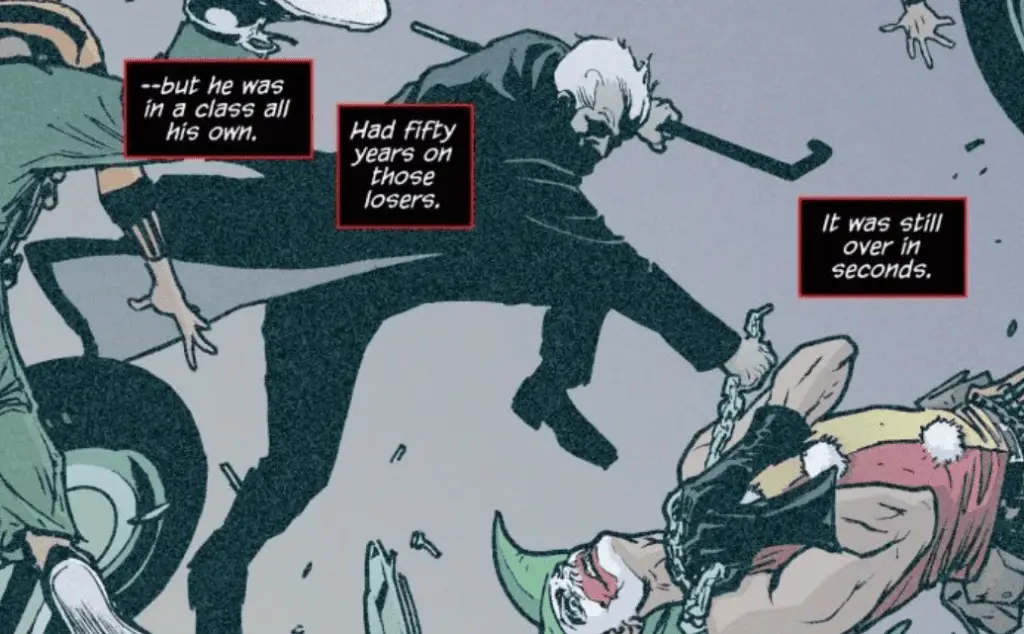
Immediately after the fight in the present day, we’re treated to Commissioner Barbara Gordon, who wants to know how Terry’s life and relationships outside of the suit are going, setting up one of the most important overarching themes of the series: Terry’s struggle to keep his life from being consumed by Batman as Bruce’s was. This also segues nicely into the next couple of scenes that introduce characters unique to the world of Batman Beyond. Terry’s love interest Dana is introduced, established as in the dark about Batman, and imperiled by the Jokerz in short order.
Then we meet Maxine Gibson and Terry’s little brother Matt, both of whom clearly do know about Batman and appear to all be living together. This scene also establishes Terry and Matt’s mother as having recently died, making Terry and Matt each others’ only living family. It excites me with the prospect of Matt actually being an important character, unlike the near-nonentity he was in the cartoon.
The need to take care of Matt is an important element in Terry’s need to keep up his life outside the batsuit, but the lines between both halves of his world are threatened when he finds out about Dana’s kidnapping from Max. Unfortunately, checking plotconvenience.com on her phone is all Max does in her two panels of presence in this issue, and I can only hope that this isn’t indicative of her importance to the story going forwards, given that she was his right hand and Oracle-level tech genius in the cartoon. Terry throws on his batsuit and goes to rescue Dana, but is almost immediately put through a wall by a mook who looks like the horrifying lovechild of Bane and the Joker.
The issue ends when Dana identifies the Jokerz leader, Terminal, as her and Terry’s former schoolmate Carter Wilson, and finds out that he apparently has the preserved corpse of the original Joker…and plans on resurrecting the Clown Prince Of Crime.
Using the Jokerz for BBR’s first plot is a decent move for a book intended for new readers as well as old thanks to how the Joker is almost as culturally ubiquitous as Batman himself. Readers of previous Batman Beyond comics are probably getting more out of Terry’s musings on Bruce’s death, his mother’s death, and his own time under Spellbinder’s control than I am, but I can still understand the effect these events have had on Terry’s life without knowing the details, and not knowing isn’t obstructive to understanding Terry as a character or the world around him.
All the key characters are introduced clearly, although I could have done with more time spent on what Maxine Gibson is presently doing with her life beyond looking after Terry and Matt (admittedly, my life needs more Maxine Gibson at all times anyway). Most importantly, their relationships to Terry are all clear, and Terry’s personal relationships are obviously going to be an important part of this series and key to Terry’s struggle to balance his sense of personal identity.
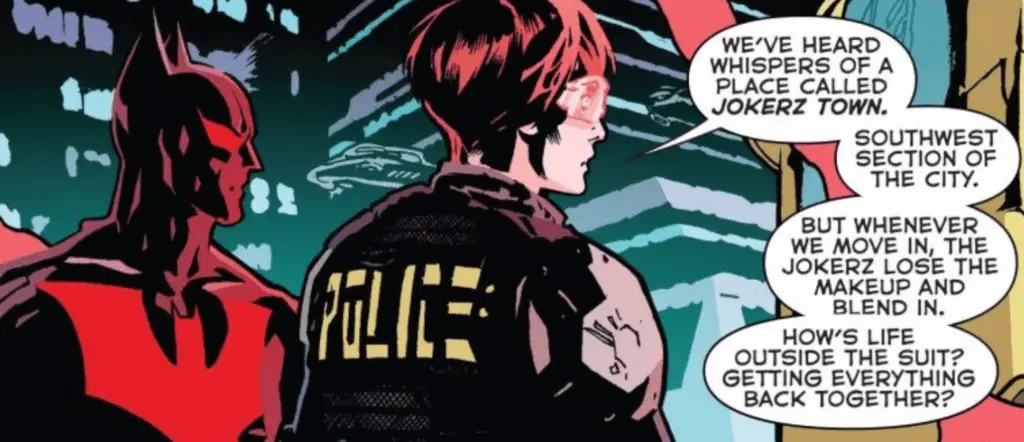
Another facet of this book that makes it easy for new readers to pick it up is the “decades from now” setting. It’s vague, but it sets the book significantly apart from pretty much every other comic that DC’s putting out just now. BBR can be read and enjoyed without much knowledge of what is going on in the rest of Rebirth and particularly the roughly eleventy billion other comics that the extended Bat-family are part of. Bruce is featured in flashback, but the only “present-day” member of the Bat-family to actually be in the chapter is Barbara, who’s here in her capacity as police commissioner rather than as a vigilante. She’s also looking a lot younger than she did in the cartoon, corresponding to how much younger she is relative to Bruce in the comics.
Setting up the key theme as Terry’s work/life balance has definite parallels to the way that Bruce is trying to deal with his personal life in the “present-day” Batman comics, but you don’t need to know anything about those comics to understand Terry’s struggle. There are, as of yet, no crossover events that require you to be following four other comics—though with all the reality-bending taking place in the “present-day” comics, I’m sure time-travelling shenanigans are in the pipeline, and I have to admit that I’m not horrified by the prospect. As much as crossover events that clearly exist just to make you pick up five more comics tend to frustrate me, I’m easily won over by time travel. While there is relevant backstory taking place in other comics, BBR is easy to read without them, and none of the references are footnoted with “see Batman Beyond #1412”, which does suggest to me that they will be explained in the fullness of time.

Issues #1-5: Escaping The Grave, or, Actually It’s Still Kinda All About Bruce
I have conflicted feelings about this arc.
Most of it continues the theme of Terry’s struggle with his identity.
In issue #1, his initial attempt to fight his way to Dana as Batman fails, prompting Max to expand a little on how Spellbinder mind-controlled Terry for several months, taking him out of action and leaving him too out of practice to go back into the field. “Can’t just roll out of bed and be Batman,” Terry thinks while the Joker-Bane beats seven shades of shit out of him.
Failing as Batman, Terry goes in undercover in issue #2, dressed up like a member of the Jokerz and going by the name “Trey Malone”, claiming to be the son of Matches Malone, an oft-used undercover ID of Bruce’s. Aside from bouncing his fake name off of Bruce’s, this approach depends almost entirely on skills and connections that Terry didn’t develop as Batman. His background as a delinquent, familiarity with gangs and the juvenile detention system all help him get in close to the Jokerz and Dana, and his initial act of deception—pretending to shoot down the Batmobile—is only made possible by the assistance of Matt and Max.
By the same token, Terry’s infiltration fails not because he’s exposed as Batman, but because he’s exposed as Terry, first recognized by Dana and then, in #3, by Terminal. Terry’s success and failure both hinge on his schoolfriends and family, not his Bat-connections. By the end of issue #3, Terry and Dana are both about to be killed by the Jokerz, Terry’s infiltration having failed just as his attack did. Going in as Batman failed, and so did going in as Terry—so how is Terry to succeed?
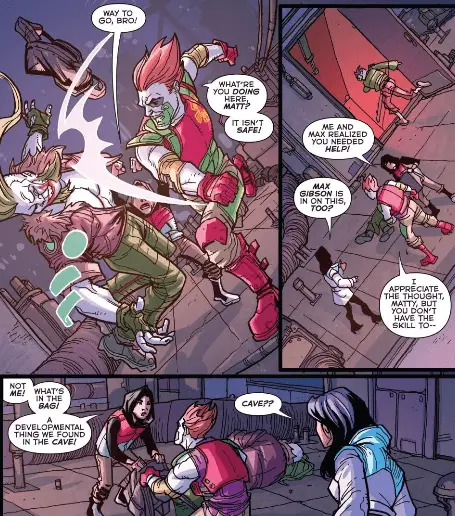
By not dividing himself in two. Matt bringing Terry a new batsuit in issue #4 represents how Terry needs both parts of his life, costumed and civilian, to be in concert for him to succeed. That this simultaneously reveals his identity as Batman to Dana (at last) further blurs the lines between being Batman and Terry. Dana is, quite understandably, furious to find out that Terry’s been lying to her for years, and this sets up Terry’s own realization that keeping secrets from people that he cares about just doesn’t work for him. Any further exploration of Terry or Dana’s feelings, at this time, is postponed by Matt pointing out that plot is still going on downstairs.
The three descend to discover that they’ve narrowly missed Terminal’s escape—and that the “Joker corpse” that Terminal’s been toting about is in fact a painted-up, comatose and completely alive Bruce Wayne. This was revealed to the reader an issue before it’s revealed to Terry, so the comic gets to use the same reveal as a cliffhanger twice before… somewhat derailing.
[tw_gallery type=”gallery,slider” height=”200″]
[/tw_gallery]
I have a theory that there’s a marketing executive somewhere in DC whose job is to turn up to every project pitch, listen carefully, and then ask, “so how does Batman fit into this?”. Bruce Wayne features, in some capacity, in more currently running comics than any other DC character, more DC animated shows and movies than any other, and has a broad selection of movies, cartoons and video games all to himself. He also has a tendency to take over anything that he’s even slightly featured in. This includes a comic where he isn’t even Batman anymore.
Bruce and members of his rogues gallery all featured in the original Batman Beyond cartoon, but over three seasons the show developed a broad enough range of new characters and villains unique to Terry to more than balance things out, whereas here, BBR’s new start works against it.
Issue #5 starts with a flashback explaining more of how Bruce came to be presumed dead (for new readers, this is the first time that it’s explained that the “war” that characters have been referencing for a few chapters was against omnicidal robots controlled by the Brother Eye satellites), how Terminal stole away with him and kept him alive, and for what purpose—to break into Wayne Enterprises and steal the y’know what, it really doesn’t even matter what he was trying to steal, because he doesn’t get to and it goes nowhere. Terry and Terminal get a couple of pages of fight before the Jokerz janitor whose face has been conspicuously kept in shadow for the past couple of chapters tries to kill Bruce, giving him and Terminal a window to escape.
Terry doesn’t finish the fight with Terminal and doesn’t even go after him, too overwhelmed with joy that Bruce is alive even as Bruce is really insistent that they have to catch that janitor. Matt and Max break out the missile launcher that Terry used to fake-shoot down the Batmobile, now apparently loaded with real ammo from somewhere somehow, to actually shoot down Terminal’s flier, which crashes a little way outside of the city. Matt and Max also make no move to go after Terminal, and Dana seems to have vanished into the ether as she isn’t in the issue at all, despite having been on the cover.
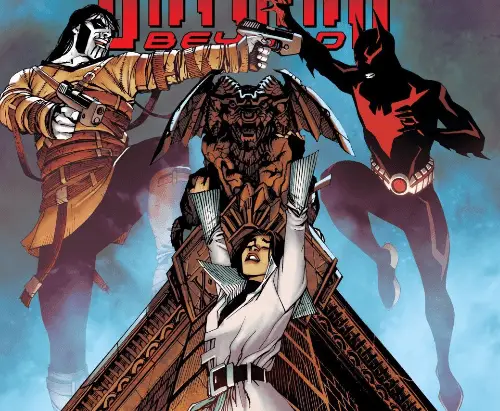
In the arc’s epilogue, Terminal is beaten to death by the janitor, who is, quelle surprise, the original Joker. He smashes Terminal’s head in with a crowbar and cackles off into the night. Terminal guessed that Terry was working for Batman, not that he is Batman, so this isn’t quite Death By Secret Identity, but Terminal’s death is pretty representative of my problem with the ending to this arc: a villain personal to Terry being brutally bludgeoned to death by a villain personal to Bruce, posited as the original and therefore superior version of that villain.
The original cartoon did run with old enemies of Bruce’s mocking Terry by comparing him to Bruce and finding him inferior, but this was always offset by Terry’s own collection of villains who’d never fought the original and Terry’s own success as Batman. Besides, Terry usually wrecked anybody who underestimated him as an “inferior” Batman, including the Joker himself in the Return of the Joker movie.
BBR has exhibited none of this. Brief mentions of Spellbinder are all we get of Terry’s unique rogues, and again, Terry doesn’t finish the fight with Terminal. Batman’s clearly winning the fight, but Terminal gets away and is taken out by the Joker instead of Terry. All the buildup and Terry’s identity issues are discarded and forgotten in favour of emphasizing the gravity of Bruce and the Joker returning to the picture.
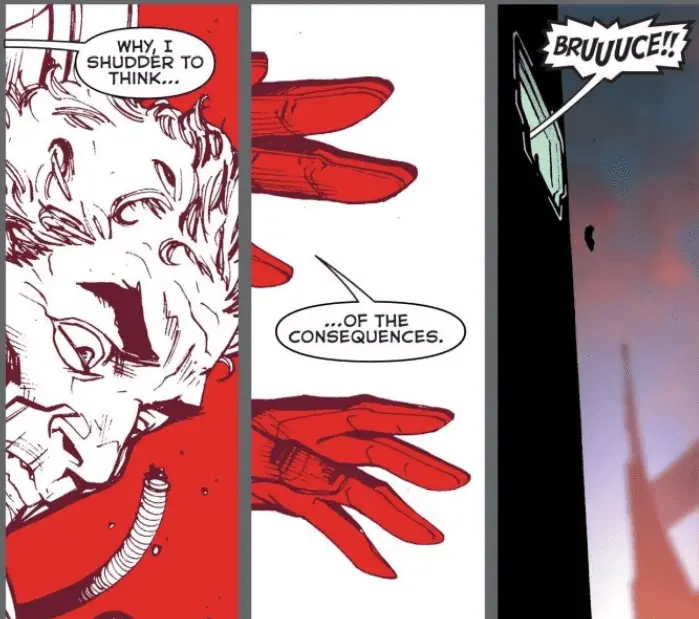
The brutality with which the Joker murders Terminal makes the reveal of his identity sufficiently unsettling, but thematically all it does is derail. It’s not purely shock-for-the-sake-of-shock, but seeing as it contributes somewhere between jack and shit to Terry’s personal character arc and themes, instead detracting from them, it does feel egregious.
Issues #6-8: Rise Of The Demon, or, Is This Even Symbolism Anymore
Recognizing the silhouette and colour scheme of Curare is enough to excite me on the first page of issue #6, as an arc dealing with one of Terry’s rogues instead of Bruce’s seems like just the thing to wash away the salt I’ve crusted up over the end of issue #5. Of course, then her pursuers have to crush my hopes by declaring that there’s no escaping the League of Assassins—at the end of #7, we find out that she’s betrayed Ra’s Al-Ghul, who is apparently still alive. Ninja assassin fights ensue, which admittedly rarely a bad thing.
The next scene in the Batcave also does a lot to restore my hopes by having Terry contest Bruce when he’s being a grumpy old man about Matt, Max and Dana being in the Batcave. Terry straight up tells Bruce that “if I was going to make Batman work, I needed friends and family around me”, bringing us back to the problem of how Terry’s going to balance his civilian and costumed lives.
He spends most of the issue explaining himself to Dana, apologizing for the years of lying as a result of following Bruce’s lead and trying to keep Batman secret from everyone in his life. But Terry’s accepted that that isn’t going to work for him, and it’s here that we see a crucial difference between Terry’s identity issues and the ones that some members of the Batfamily are dealing with in the present day. Kate wants to do things that Batman can’t, Jason thinks about being somebody that Batman can’t, but Terry has a completely different problem. He is Batman, but he isn’t Bruce, and he needs to find a way to do what Bruce couldn’t do, which is have a personal life.
As much as Terry clearly love and respects Bruce, he can’t keep doing things his mentor’s way, not unless he wants to end up old and alone like Bruce was when they first met. Being there for Matt is just as important to Terry as being Batman, and so is being with Dana, to the extent that he’s willing to ignore the Batsignal to spend more time with her… Only to find, to his horror, that he managed to do this the one time that Commissioner Gordon wasn’t turning on the Batsignal because she was waiting to speak to him, but because she and Curare were being attacked by an army of assassins.
Terry’s attempt to prioritize his relationship with Dana nearly costs Barbara and Curare their lives, but what’s eating at Terry throughout his conversation with Dana is that prioritizing Batman cost him his relationship with her, his chance to say goodbye to his mother and nearly his brother. Is balance between Terry and Batman even possible?
Terry sets the question aside to fight the League of Assassins, but Bruce carries the theme for him by opening #7 with his musings on how losing his parents may have cost him the ability to find that balance himself. He thinks on the past partners he’s had who are no longer in his life—the male ones, anyway.
Some of the few comics I read before finding Rebirth were a friend’s Cassandra Cain and Stephanie Brown Batgirl comics, which are what got me genuinely interested in the extended Bat-verse in the first place, so I’m severely dischuffed that they’ve both had their superhero histories erased, and reset while Dick, Jason and Tim’s backgrounds as Robin have all been preserved. Kate Kane is also noticeably absent, despite Batwoman and Batman’s partnership being important to the “present-day” Detective Comics.
Anyway, pushing my bitterness aside to look at Bruce’s, it is noticeable that in the flashback to his last fight with the Joker in the previous arc, nobody was fighting alongside him except Barbara, and as a police officer, not a vigilante. In #8 we also get a flashback to Bruce’s very last outing as Batman, against “the Banes”, four criminals on Bane’s formula to bulk them up. Once again, Bruce was fighting completely alone, to the extent that when he lost, he doesn’t seem to have anybody to turn to for help—prompting him to build the X-7, the powerful experimental suit that Matt brought to Terry in issue #4.
The suit’s original purpose might have been foreshadowed by the fact that Terry first used it to defeat the amped-up Bane/Joker mook. In #7, we discover that one aspect of the suit that wasn’t immediately apparent is that it contains an AI that takes over when the wearer is struggling to ensure that Batman wins the fight, no matter the cost. The last time Bruce wore the suit, it kept him fighting through multiple cracked ribs and vertebrae. When Terry wants to abandon pursuing Ra’s to help Curare, the suit refuses to let him. The X-7 was, according to Bruce, designed to think like him, but it’s driven to an extreme that is unsustainable. Bruce reveals that in this continuity, he gave up being Batman because he could no longer fight without the X-7, and it was either going to kill him or cause him to kill somebody else.
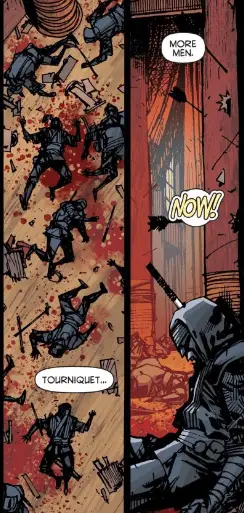
Bruce briefly mentions that somebody else wore the X-7 once, but refuses to expand on who or what happened. My guess is that it was Damian—Bruce spends a lot of #7 thinking about how he ruined his relationship with Damian in particular, he gets distracted by thoughts of how Matt reminds him of Damian, and, oh yeah, Damian is Ra’s Al-Ghul. Now that’s a development that has me excited for this arc.
In a sense, this is still an arc that’s about Bruce’s past struggles, but unlike the Joker’s return, this is also immediately relevant to Terry’s personal struggles. He’s wearing a suit that’s manifestation of Bruce at his most extreme (in the last arc, Terry complained of missing having Bruce’s voice in his ear—be careful what you wish for, Terry), and the enemy he’s facing now may very well be a direct result of Bruce prioritizing Batman over having personal relationships. He is literally fighting against Bruce’s legacy, both in fighting Damian and fighting against the suit’s dangerous AI. As a result, this arc’s plot is much better connected to Terry’s personal struggle to find a balance between Batman and Terry.
Earlier, when he tried to choose being Terry and being with Dana over being Batman, the results were nearly deadly for Barbara and Curare (though Curare is apparently killed in #8 anyway by Koru, Damian’s version of Ubu), but it’s never been more obvious that choosing to be Batman above all else has destructive consequences.
How Terry handles this fight will define how he handles being Batman going forward, and this seems like a great setup for having Terry overcome any self-doubts about his ability to be Batman or his place in Bruce’s shadow. I’m also interested to find out the exact circumstances that drove Damian away from Bruce and back into the League of Assassins—it seems like a hell of a downer, to read the “present-day” comics and know that Damian will grow up to abandon heroism for the League of Assassins, though it’s also possible that this isn’t a direct future to the present comics, but rather a possibility if present-day Bruce never makes any steps to get his life together.
Only more flashbacks will tell, and I’m just hoping that they don’t start to overwhelm Terry’s struggles as the Joker did.
Overall Thoughts
This comic is easy to get into for new and old fans alike, an enjoyable read with signs of a real emotional centre, but at the moment it’s as off-balance as Terry himself for exactly the same reason: Bruce Wayne’s legacy overwhelms everything new and original about the time of Batman Beyond. It’s seductively interesting to find out what’s going to happen to beloved characters decades in the future. Where did their lives take them? Who lived? Who died? Who told their story? Who’s married, has kids, single, still a vigilante, has a life outside vigilantism? I want to know, believe me, but not at the expense of the characters that this comic is actually about.
There are strong possibilities for this arc, with Terry fighting Damian, to directly address and combat this problem, but the book definitely needs a lot more of Max, Matt, Dana and Terry’s rogues gallery. Max and Matt had a lot of great scenes in the first arc—I’m particularly emotional about the heartfelt hug the two share before they embark on their plan to get a batsuit to Terry—but they’ve been dialed back to props to trigger exposition from Bruce in the second. With how much the comic thus far has talked up Terry’s need to balance his personal relationships with his vigilantism, they have to become more involved with the resolution for the arc for it to have any reading, as does Dana. I’m as happy as any of the characters to see Grumpy Grampa Bruce still alive, but in this comic, he’s not the goddamn Batman anymore. Terry is. I just hope BBR doesn’t forget it.

Random extra thoughts
- Damian, as an adult, looks like Bruce with his eyebrows set on Bold.
- There’s no indication, as of yet, of the canonicity of the controversial Justice League episode that established that Terry and Matt are Bruce’s biological sons due to some genetic manipulation by Amanda Waller. Terry’s parents have only been shown in this book so far in a blue-wash holo-pic, so one or the other of them may have had their colouring redesigned to make it more plausible that the black-haired and blue-eyed McGinnis brothers are their sons, or the whole concept might have just been dropped and ignored. But if it is canon to this version, it adds another interesting level to the current arc: Terry’s fighting his half-brother over Bruce’s legacy. It also makes Matt reminding Bruce of Damian just that touch sadder.
- I like a lot of the art in this series, especially the repeated use of reflections to depict characters in emotional moments; I don’t know if it’s symbolic or aesthetic but it looks great. The way Terry’s batsuit is drawn is sometimes a bit weird, though, especially the eyes.
- I really do hope we see more of Terry’s rogues gallery soon. My personal vote is for Inque, just because I really like her, or the Royal Flush Gang, because Ten/Melanie was a character that the cartoon often made good use of in showing how complicated the divide between Terry’s personal life and his life as Batman is. With this book spending so much time discussing how unsustainable that divide is, she’d be a great addition to the cast. Also, her struggle to break away from her family to live a regular life was heartwrenching and I loved her whole character arc.
- For things I hope aren’t kept from the cartoon, I really hope that the reason the Joker’s alive is pure diabolus ex machina and not… what happened in the movie. That movie was fucked up.
- Okay, I’ve been dancing around the issue, but I’ll cut straight to the chase and ask the real question: Where the hell is Ace? Does he just not exist in the comics at all or was he killed by evil robots? If Bruce’s dog was killed by evil robots I’m gonna be so mad


